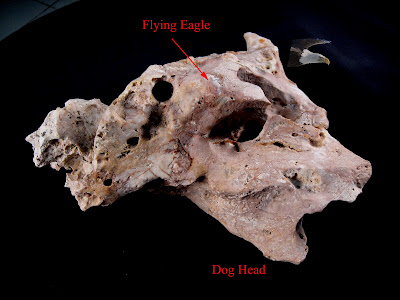Part 1 - The scream mask
The famous painting with an image of the stone face mask artfully inserted
The famous painting with an image of the stone face mask artfully inserted
Stone mask evocative of "The Scream" found by Tira Vanichtheeranont on the surface at the cave near Kanchanaburi, Thailand. Artistic rendering by Tira Vanichtheeranont. There are three parts to the interpretation here. Ken Johnston contributes a human interpretation to Part 2 and makes all the interpretation of part 3.
Tira Vanichtheeranont demonstrating how she suspects the mask was held during prehistoric human cultural use. (click photos to expand)
The scream mask with CM scale
Regarding the origins of art, Patricio Bustamante writes: "Leon Battista Alberti, (1464) in his treatise “De Statua” describes the mode in which he thinks sculpture begun:
I believe that arts that aspire to imitate the creations of nature were originated according to the following scheme: on the trunk of a tree, a cloud of earth, or on any other thing, were accidentally discovered one day certain contours that needed only a few retouches to notably look like a natural object. Focusing on that, men examined if it was possible, by means of addition and subtraction, to complete what was missing to achieve the perfect resemblance. Thus, by adjusting and removing features according to the scheme required by the object itself, men succeeded in what they intended to do, and no without pleasure. From that day on, men´s ability to create images was growing until they knew how to form any kind of resemblance, even when the material did not present outlines that guided the labour.” (cited by Gombrich 1959).
Pareidolia supplies an adequate explanation for this process."
The artifact in different lighting and position. All the water worn surfaces provide fantastic natural sculpted forms which are ripe for the application of the human imagination and creativity.
Close up of the human face in left profile view
Part 3 - Horse head left profile view with subtle human face mask like (Part 1 - The mask) on far right. The mask seems to connote movement leftward with the horse. The mask may be seen as incorporated into the windblown mane of the horse.
Markups of the horse mouth in red, nose and eye in white, and subtle human face mask on right. (click photos to expand).
Thank you very much Tira for your fine photographs of this amazing example of portable rock art from Thailand.
-kbj







+3.jpg)


The canis lupus dingo is known to have originated in Thailand/Vietnam area around six thousand years ago from the Asian wolf.the dingo has its mouth open howling giving it a sort of an optical illusion of a even shorter jaw line then it all ready has.the human mouth maybe howling instead of screaming.with the turning horse head included as well, the theme maybe one of multiple species working together which would have caused great amazement among early humans to see wild animals working with them instead of against them in a hunter/prey world which they lived in. The cave should be excavated if possible they pulled a 5 thousand year old dingo skull from a Pakistan cave and that's a lil lil ways from Thailand area were the dingo originated.the rock was placed there for a reason that might not be it but it could and would go along way to prove the usefulness of rock art in decoding the past .
ReplyDelete